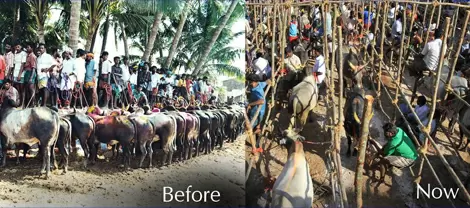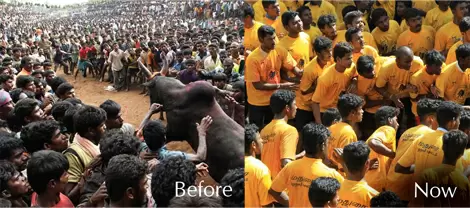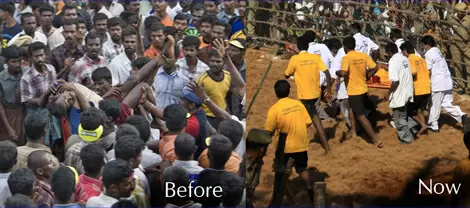With so many regulations in place, Jallikattu qualifies for a sport

12-January-2012
Vol 3 | Issue 2
As one who has covered Jallikattu events for many years, and someone who has interacted with the brave men who tame the raging bull, I now feel strongly that those who are raising a hue and cry opposing the bull taming event, which is quintessentially Tamil, are only out to banish aspects of Tamil culture and tradition that stand out.
For one, the sport has become more organized now with the direct intervention of the district authorities. Representatives from animal rights organizations are allowed to be present at the sporting arenas to monitor if the animals are subjected to any acts of cruelty.
 |
|
Jallikattu is more disciplined now. The above photos show the situation as it existed few years ago when crowds perched dangerously atop buildings to watch proceedings and the situation now – spectators are seated at specially erected galleries (Photos: Senthil Kumaran)
|
Only players with proper uniform that have numbers on the back are allowed into the ring. Ambulances with doctors are in standby to rush injured players for treatment and veterinarians check if the animals are drugged.
The playing arena is barricaded. There are separate spectator galleries, so that spectators cannot come anywhere close to the bulls.
In fact, the event has become a major tourist attraction during the Pongal season. Foreign tourists I have spoken to have praised the sport and compared it to the Spanish bullfight, which they felt was gory.
It just looks like a war of culture to me as the same people, who are shouting from the roof tops demanding a ban on Jallikattu by roping in film stars for their campaign, are not saying anything about elephants being used for ‘performance’ in Kerala temple festivals or pedigree dogs being paraded in elite dog shows.
 |
|
Unlike in the past, the participating bulls are examined thoroughly by veterinarians before they are let into the playing arena
|
Personally, I have nothing against elephants being used in temple festivals and dogs being made to perform in competitions. They all offer ample photo opportunities. But the question is: Why is Jallikattu being singled out? Why is it being branded as ‘brutal’, ‘barbaric’, ‘primitive’ and ‘gory’?
I will not be surprised if those derogatory terms are soon used against ‘us’ - meaning people like me who eat meat. For, the same organisations that have picked on Jallikattu are also ardent advocates of vegetarianism.
 |
|
It is no longer free-for-all in the playing arena. Only players with uniforms are allowed in the ring and those found violating rules - like pulling the bull’s tail - are sent out of the field immediately
|
The entire idea behind the demand for a ban on Jallikattu, which is pursued aggressively through court cases and letters by film stars to governments, is a bid by the urban educated elite to define the rights and wrongs for rural communities belonging to the subaltern classes and disconnect them from their cultural roots.
There is even a bid to portray the sport as one having no links to Tamil culture and history though there is evidence to prove its antiquity - the sport finds mention in many literary works of the Sangam period (500 BC to 200 AD) like ‘Kali Thohai’.
It is a different matter that the elite cannot appreciate the valour of the youth who look forward to the annual event in their village to show demonstrate their strength. But why should they look down upon them?
I wonder how they allege that the sport involves cruelty to the animals. I know for sure that the bulls are exclusively bred for the day and brought up like ‘children’ in one’s family on special nutritious diet and taken off the chores that other cattle are assigned.
 |
|
Medical help was not available to treat injured players in the past. Now, doctors attend to injured players immediately
|
Earlier they said that bull owners make the animals imbibe alcohol before the event. Now there is a mechanism in place to detect any such abuse.
If some people feel that the bulls are made to ‘perform’ certain ‘unnatural acts’, why have they not clubbed the elite dog shows and the elephant parades in temples in their list of events that should be banned?
With new rules in place, even the old charges of twisting the tails of the bulls and rubbing chilli powder in their private parts, are no longer valid. Yet if the animal rights lobby is so bullish about a ban, it can be only because they care two hoots for the cultural sensibilities of the powerless ‘others’ and only seek to impose their own lifestyle code.
As urbanites, they are not bothered that the village communities even fear invoking divine wrath by not holding the event. It is only absurd that an urbanite teaches a villager how to treat cattle, which form the mainstay of rural economies.
Not only do the villagers have a better interface with all animals, cows and bulls are prized possessions for them.
So, let me conclude, the demand for the ban on Jallikattu is only aimed at destroying Tamil culture. It is happening in many ways, Jallikattu is just one of them.
Senthil Kumaran is an award winning photographer and THE WEEKEND LEADER’s Consulting Photo Editor
Also Read
Jallikattu adapts to changing times, sport here to stay
















